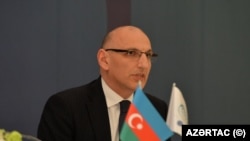The Armenian Constitution contains language that Baku says amounts to official Armenian claims against its territory: a reference to “reunification” with Nagorno-Karabakh, the territory at the heart of the two countries' conflict.
That clause “clearly poses a territorial threat to Azerbaijan,” Azerbaijani President Ilham Aliyev said at a July 20 press conference. “So, [while] this paragraph is there, a peace agreement is not possible.”
Armenian Prime Minister Nikol Pashinian has signaled that he is willing to alter the document in the way that Aliyev wants and has tasked a council of politicians and activists to draw up a new document to be put to the Armenian people in a referendum.
But as the issue has risen to the top of the agenda between the two foes, the perception that their main enemy is dictating the content of their country's constitution has rankled Armenians upset at the concessions they have already made. And since a referendum may be required to change the constitution, the Azerbaijani pressure could prove fatal.
Problematic Preamble
Voters in Yerevan recently surveyed by RFE/RL’s Armenian Service were largely opposed to changing the constitution. Pashinian “doesn’t have the right” to change the constitution, “especially since it is Aliyev who is demanding it be changed,” one man said. “Who is Aliyev to order us to change our constitution?”
Azerbaijani leaders, though, remain confident that they will get their way.
“It’s not about doing it under pressure from Azerbaijan, but it’s about you answering one question: Do you want peace or do you want a possibility for a new confrontation with Azerbaijan?” Elchin Amirbayov, Aliyev’s senior envoy for special assignments who has been closely involved in the negotiations, told RFE/RL.
“If they put it that way, I think a majority of Armenian people who would participate in that plebiscite or referendum, I'm sure that they would support peace.”
At issue is a reference in the preamble of the current Armenian Constitution to a 1989 declaration of independence -- when Armenia was still part of the Soviet Union -- that calls for the reunification of Armenia and what was then the Nagorno-Karabakh Autonomous Oblast, part of Soviet Azerbaijan.
Nagorno-Karabakh was populated largely by ethnic Armenians, and as the Soviet Union collapsed, war over the territory broke out and Armenian-backed separatists managed to seize control. They also took control of seven adjacent Azerbaijani districts, forcing the entire population of more than 600,000 ethnic Azerbaijanis to flee.
Diplomatic efforts to settle the conflict brought little progress. The two sides fought another war in 2020 that lasted six weeks before a Russian-brokered cease-fire, resulting in Armenia losing control over parts of the region and the seven adjacent districts. In 2022 the two sides started negotiations over a full resolution over the conflict. But the following year, Azerbaijan, impatient with the progress of those talks, launched a one-day offensive that resulted in the Karabakh’s leadership’s full surrender and the exodus of more than 100,000 ethnic Armenians.
In the course of the post-2020 negotiations, Pashinian has said he is willing to formally recognize Karabakh as part of Azerbaijan. But Azerbaijan argues that, as long as the claim to Karabakh remains enshrined in Armenian law, there will be a danger of post-Pashinian governments going back on that declaration and relitigating its claims to Karabakh.
“We want to be reassured that the peace agreement is a kind of a solemn treaty that would render impossible any return to revanchism or to any territorial claims to Azerbaijan in the future as it had done in the past,” Amirbayov said. “Territorial claims against Azerbaijan that are embedded in the current Armenian Constitution continue to remain the main, and I would say pretty much the only, obstacle to further progress in the peace process.”
Armenia, for its part, argues that Azerbaijan’s demand amounts to meddling in its internal affairs -- and moreover, is designed to sabotage the entire process. Azerbaijan's public demand to change the constitution “torpedoes the peace process and casts doubts on the sincerity of the leadership of Azerbaijan to achieve peace,” the Armenian Foreign Ministry said in a June 7 statement.
Amirbayov rejected that argument: “How can we in Azerbaijan consider this to be an internal issue when it deals with our sovereign territories?”
‘Real Armenia Vs. Historical Armenia’
Pashinian’s own agenda with respect to the constitution has been ambiguous.
He began changing the constitution soon after coming to power in 2018, but his focus was initially on internal governance issues. In 2022, he formed a new Constitutional Reform Council to work on amendments to the current document. This year, though, he asked the council to instead draft an entirely new constitution, apparently blindsiding the participants.
“There are lots of issues that are not clear to us,” Artur Sakunts, a human rights advocate and member of the council, told RFE/RL’s Armenian Service in June.
In the meantime, Pashinian had begun talking about the need to remove the contentious language from the constitution. In one interview in January, he said that keeping the controversial reference “means that we’ll never have peace.”
In July, on the occasion of Armenia’s Constitution Day, the Armenian president said that the current document is “[immersed] in deep socio-psychological conflict” and should reflect the interests of “real people living in Real Armenia,” a trope that Pashinian has developed to contrast to what he calls “Historical Armenia,” the maximalist dream of recovering lost lands. The new constitution, he continued, should “create a just environment in its internationally recognized territory.”
It remains unclear, though, how these ambitions will be implemented by the constitutional council.
Members of the council told reporters in June that they did not discuss the declaration of independence issue in their first meeting since being instructed to draft a new constitution. And several members of the council appear to be at odds with Pashinian on the issue.
Sakunts said he opposed removing the reference to the declaration of independence. Another member, Daniel Ioanissian, wrote on Facebook: “Ilham Aliyev is not a citizen of Armenia. Many things can be discussed with him but not the future constitution of Armenia.”
Pashinian’s council is supposed to produce a document by the end of 2026, which would then be put to voters in a 2027 referendum. Even if Armenians did ratify the constitution, that would present a significant delay to a process that all parties agree is otherwise very close to being finished.
The June statement from the Armenian Foreign Ministry said an agreement could be reached “within the next month.” Aliyev said that “80 to 90 percent of the text is agreed on.” U.S. Secretary of State Anthony Blinken, ahead of a July 10 meeting with his Armenian and Azerbaijani counterparts, said the two sides were “very close to being able to reach a final agreement, one that the United States would strongly, strongly support.”
The Other Sticking Point
One factor that is easing the negotiations, according to Amirbayov, is that the two sides have agreed to put off the most contentious remaining issue: how to arrange the transportation routes that have become known as the “Zangezur Corridor.” The proposed Zangezur Corridor would connect mainland Azerbaijan to its Naxcivan exclave by traversing the Syunik Province (known by Azerbaijanis as Zangezur) in southern Armenia.
“On mutual agreement, we decided to take this paragraph out of the peace agreement and to refer it to a later stage,” he said. “I don’t want to complicate even further the task of finalizing the peace agreement. So, we decided to take it out of the text, but we can still reflect in the text [on] the fact that this is one of the other issues on which the countries may come back at some point to discuss and to come to a common agreement.”
The Armenian Foreign Ministry did not respond to a request for comment.
Even without the knotty transportation issue to contend with, the standoff over the Armenian Constitution threatens to delay a signing of an agreement indefinitely.
Azerbaijan has recently proposed a kind of interim “basic principles” agreement that could be signed before a full peace agreement -- for Azerbaijan, ideally before the COP29 climate summit, which is scheduled to be held in Baku in November. Armenian officials have objected, though, saying that the full agreement is nearly ready and an interim agreement would only allow Baku to drag out the process and add more conditions.
“It’s not that the issue itself [of the reunification language in the constitution] is not valid, but it’s the way it’s been raised, this rather public, confrontational way rather than something to be overcome through quiet negotiation,” said Thomas de Waal, a senior fellow at Carnegie Europe.
It is characteristic of Baku’s “coercive diplomacy” since 2020, de Waal said. “They think this tactic works, [and] they don’t seem to have another tactic,” he said. Rather than publicly emphasizing cooperation with Armenia’s government, “it’s all about what the Pashinian government needs to do to meet our demands.”
The only other explanation “for the constitutional demands” is that Azerbaijan “isn’t desperate for a peace agreement,” de Waal said. Even if Azerbaijan holds firm on the demand to change the constitution before a full agreement could be reached, Armenia likely would accede to a “basic principles” document, said Richard Giragosian, the head of the Yerevan-based Regional Studies Center think tank.
“We’re not going to refuse an opportunity to reach some kind of agreement,” he said. “In an ideal world, let’s keep moving [toward] a full bilateral peace treaty and close the issue, turn the page. But we are, in Armenia, I think, willing to settle for whatever the hell we can get, to be quite honest.”
Hard Bargaining
As the negotiations have progressed, Armenia has already agreed to other unilateral concessions. This spring, Pashinian agreed to return four slices of land along Armenia and Azerbaijan’s northern border, which Armenia had occupied since the 1990s, to Azerbaijan. He did so without getting Azerbaijan to reciprocate -- as many Armenians had hoped -- by withdrawing its troops that have occupied small slices of Armenian territory after a series of incursions after the 2020 war.
Pashinian has repeatedly justified the concessions as being the cost of avoiding an attack from Azerbaijan. Not returning the land along the northern border, he said in March, would “mean a war will break out at the end of the week.”
While Azerbaijan’s hardball tactics have worked as long as it is Pashinian making the decisions, it will be more complicated when Armenian voters have to weigh in to ratify what they perceive as Aliyev’s demands.
If Azerbaijan’s demands were reflected in the new constitution, Armenians would vote it down in the referendum, said another member of Pashinian’s constitutional council, Edmon Marukian. This, he told RFE/RL’s Armenian Service, would give Baku a “pretext for a new war.”
“That is why I believe we must not touch the preamble to the constitution or get into any discussion of this,” he said. “This is a trap.”








